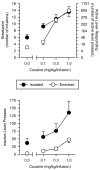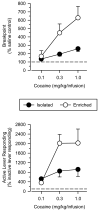Effects of environmental enrichment on sensitivity to cocaine in female rats: importance of control rates of behavior
- PMID: 19584714
- PMCID: PMC2741423
- DOI: 10.1097/FBP.0b013e32832ec568
Effects of environmental enrichment on sensitivity to cocaine in female rats: importance of control rates of behavior
Abstract
Environmental enrichment produces functional changes in mesolimbic dopamine transmission and alters sensitivity to psychomotor stimulants. These manipulations also alter the control rate of many behaviors that are sensitive to stimulant administration, which can make comparison of drug effects between isolated and enriched subjects difficult. The purpose of this study was to examine the effects of environmental enrichment on control rates of behavior and on sensitivity to cocaine in tests of locomotor activity, drug self-administration, conditioned place preference, and toxicity. In the locomotor activity test, isolated rats exhibited greater activity after the administration of cocaine, but also had higher control rates of activity. When locomotor activity was expressed as a percentage of saline control values, enriched rats exhibited a greater increase relative to their own control than isolated rats. In the drug self-administration procedure, isolated rats had higher breakpoints on a progressive-ratio schedule of reinforcement when responding was maintained by cocaine; however, isolated rats also had higher breakpoints in saline substitution tests and higher rates of inactive lever responding. When the self-administration data were expressed as a percentage of these control values, enriched rats exhibited a greater increase in responding relative to their own control rates than isolated rats. No differences were observed between isolated and enriched rats under control conditions in the place preference and toxicity studies. In both of these procedures, enriched rats were more sensitive than isolated rats to all the doses of cocaine tested. These data emphasize the importance of considering control rates of behavior in studies examining environmental enrichment and drug sensitivity, and suggest that environmental enrichment increases sensitivity to cocaine across a range of dependent measures when differences in control rates of behavior are taken into account.
Figures





Similar articles
-
Effects of medial prefrontal or anterior cingulate cortex lesions on responding for cocaine under fixed-ratio and second-order schedules of reinforcement in rats.Psychopharmacology (Berl). 1997 Dec;134(3):242-57. doi: 10.1007/s002130050447. Psychopharmacology (Berl). 1997. PMID: 9438674
-
Repeated social-defeat stress, cocaine or morphine. Effects on behavioral sensitization and intravenous cocaine self-administration "binges".Psychopharmacology (Berl). 2001 Dec;158(4):388-98. doi: 10.1007/s002130100858. Epub 2001 Aug 18. Psychopharmacology (Berl). 2001. PMID: 11797060
-
Injection of the 5-HT2C receptor agonist Ro60-0175 into the ventral tegmental area reduces cocaine-induced locomotor activity and cocaine self-administration.Neuropsychopharmacology. 2004 Feb;29(2):308-18. doi: 10.1038/sj.npp.1300319. Neuropsychopharmacology. 2004. PMID: 14666118
-
Sensitization to the reinforcing effects of cocaine following binge-abstinent self-administration.Neurosci Biobehav Rev. 2004 Jan;27(8):803-12. doi: 10.1016/j.neubiorev.2003.11.004. Neurosci Biobehav Rev. 2004. PMID: 15019429 Review.
-
Rats classified as low or high cocaine locomotor responders: a unique model involving striatal dopamine transporters that predicts cocaine addiction-like behaviors.Neurosci Biobehav Rev. 2013 Sep;37(8):1738-53. doi: 10.1016/j.neubiorev.2013.07.002. Epub 2013 Jul 12. Neurosci Biobehav Rev. 2013. PMID: 23850581 Free PMC article. Review.
Cited by
-
Chronic wheel running reduces maladaptive patterns of methamphetamine intake: regulation by attenuation of methamphetamine-induced neuronal nitric oxide synthase.Brain Struct Funct. 2014 Mar;219(2):657-72. doi: 10.1007/s00429-013-0525-7. Epub 2013 Feb 27. Brain Struct Funct. 2014. PMID: 23443965 Free PMC article.
-
Early environmental enrichment and impoverishment differentially affect addiction-related behavioral traits, cocaine-taking, and dopamine D2/3 receptor signaling in a rat model of vulnerability to drug abuse.Psychopharmacology (Berl). 2021 Dec;238(12):3543-3557. doi: 10.1007/s00213-021-05971-z. Epub 2021 Aug 31. Psychopharmacology (Berl). 2021. PMID: 34463825 Free PMC article.
-
Access to a running wheel inhibits the acquisition of cocaine self-administration.Pharmacol Biochem Behav. 2011 Dec;100(2):237-43. doi: 10.1016/j.pbb.2011.08.025. Epub 2011 Sep 6. Pharmacol Biochem Behav. 2011. PMID: 21924284 Free PMC article.
-
Pharmacological manipulation of glucocorticoid receptors differentially affects cocaine self-administration in environmentally enriched and isolated rats.Behav Brain Res. 2015 Apr 15;283:196-202. doi: 10.1016/j.bbr.2015.01.049. Epub 2015 Feb 2. Behav Brain Res. 2015. PMID: 25655510 Free PMC article.
-
Local cerebral glucose utilization in rats exposed to an enriched environment: a comparison to impoverishment.Pharmacol Biochem Behav. 2010 Oct;96(4):521-5. doi: 10.1016/j.pbb.2010.07.015. Epub 2010 Jul 27. Pharmacol Biochem Behav. 2010. PMID: 20673779 Free PMC article.
References
-
- Barat SA, Abdel-Rahman MS. Cocaine and lidocaine in combination are synergistic convulsants. Brain Res. 1996;742:157–162. - PubMed
-
- Bardo MT, Bowling SL, Rowlett JK, Manderscheid P, Buxton ST, Dwoskin LP. Environmental enrichment attenuates locomotor sensitization, but not in vitro dopamine release, induced by amphetamine. Pharmacol Biochem Behav. 1995;51:397–405. - PubMed
-
- Bardo MT, Klebaur JE, Valone JM, Deaton C. Environmental enrichment decreases intravenous self-administration of amphetamine in female and male rats. Psychopharmacology. 2001;155:278–284. - PubMed
-
- Bennett EL, Rosenzweig MR, Diamond MC. Rat brain: effects of environmental enrichment on wet and dry weights. Science. 1969;163:825–826. - PubMed
-
- Bowling SL, Bardo MT. Locomotor and rewarding effects of amphetamine in enriched, social, and isolate reared rats. Pharmacol Biochem Behav. 1994;48:459–464. - PubMed
Publication types
MeSH terms
Substances
Grants and funding
LinkOut - more resources
Full Text Sources

